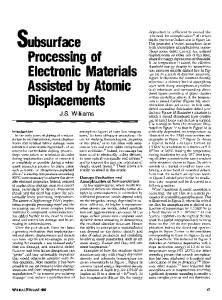Ion-Assisted Processing of Electronic Materials
- PDF / 2,946,817 Bytes
- 3 Pages / 576 x 777.6 pts Page_size
- 9 Downloads / 372 Views
importance. With the range of new processes currently under active research, this trend seems likely to continue. The technological applications of ionassisted processing rest on the basic concepts developed in research over the past 30 years. This special issue of the MRS Bulletin reviews the fundamental concepts that underpin this processing today, and highlights areas of current research which may have future technological potential. The emphasis is placed heavily on silicon, both for illustrative purposes, and because Si processing is the major customer for ion-assisted technology. The articles pinpoint areas where materials research can play a critical role in establishing the fundamental understanding needed for a real-
istic assessment of technological potential. In the first article, J.A. Davies outlines the concepts governing the interaction of single energetic ions with solids at very short times. We then discuss the response of the material with increasing ion f luence and on time scales that are experimentally accessible. T.E. Seidel and L.A. Larson address one of the most important and widespread applications of ion implantation: introduction of electrically active impurities at low or medium doses for integrated circuit (VLSI) purposes. Alice E. White and G.K. Celler extend the discussion to very high doses, where new phases are formed in subsurface regions of a material. They show, for example, how buried insulating, metallic, or semiconducting phases can be produced by ion implantation into Si. J.S. Williams describes how amorphization processes, particularly in subsurface regions, occur and how they may be used to modify the properties of materials. Finally, ST. Picraux, E. Chason and T.M. Mayer outline the role of lowenergy ions in deposition of thin layers of material or in removal of thin layers, in each case with exquisite control. It is difficult to predict which, if any, of the areas discussed in this issue will find extensive application in the next decade. That is why we are engaged in research. But there can be little doubt that the role of ions in electronic materials processing will continue to expand in ways that are critical to future technologies.
JUST PUBUSHED BY MRS Phase Formation and Modification by Beam-Solid Interactions Studies the modification and transformation of phases in a wide variety of materials: semiconductors, metals, ceramics, fullerenes, and superconductors—using a number of different types of energetic beams: lasers, ions, electrons, clusters, and neutral particles. 1992, hardcover, 139 papers, 911 pages. ISBN: 1-55899-129-8 Code: 235 - B $44.00 MRS Members $50.00 U.S. List $65.00 Foreign Volume 235 in the MRS Symposium Proceedings Series (1991 MRS Fall Meeting, Boston, MA) Editors: Gary S. Was, Lynn E. Rehn, David M. Follstaedt
Interface Dynamics and Growth Recent progress in theoretical and experimental understanding of the nature of interface motion and growth morphology. 1992, hardcover, 98 papers, 689 pages. ISBN: 1-55899-131-X Code: 237 - B $44.00 MRS Memb
Data Loading...











